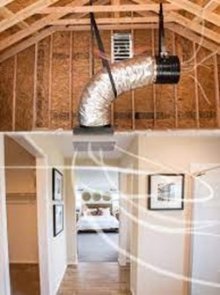Whole house fans can be an energy-efficient alternative to air conditioning in some climates. Combined with ceiling fans and other circulating fans, they can provide comfortable summer conditions for many families.
How Whole House Fans Work
Whole house fans pull outdoor air into a home through open windows and exhaust it through vents in the attic and roof. This air circulation, in cubic feet per minute (CFM) provides cooling both in the house and the attic. Whole house fans should be designed to provide an air flow that is at least one half the total volume of the house (for example, an 8,000 ft3 house would need at least 4,000 CFM of airflow). Consult with a qualified professional to determine the appropriate airflow for your home.
The cooling effect of whole house fans comes from the air circulation they generate, rather than from any cooling or heating components. They are most effective when outdoor temperatures are lower than indoor temperatures, as they quickly draw in the cooler outdoor air while exhausting warmer indoor air.
Installing and Using a Whole House Fan
Installing a whole house fan should be done by a professional. The installer should:
- Measure your attic space accurately.
- Install dedicated circuit wiring.
- Add additional attic vents if necessary.
Proper attic ventilation is crucial. You will need 2 to 4 times the normal vent area, which equates to about one square foot of net free area for every 750 cubic feet per minute of fan capacity. More vent area allows for optimal performance.
Since whole house fans are not typically used during winter months, they should be equipped with an air-tight cover. If an existing fan doesn't have a tight-sealing winter cover, purchase or build one. If you switch between air conditioning and whole house fan cooling, consider a tightly sealed, hinged door accessible from the living space for the fan opening for easy switching.
Safe Operation Tips
- Open Windows: Ensure windows throughout the house are open to avoid powerful, concentrated suction in one location.
- Ventilation: Proper ventilation prevents backdrafting from gas appliances, which can pull combustion products like carbon monoxide into your home.
Drawbacks of Whole House Fans
- Humidity Control: Whole house fans do not dehumidify air like air conditioners and heat pumps, making them less suitable for high-humidity climates.
- Air Filtration: They do not filter outdoor air, which can be problematic for residents sensitive to outdoor pollutants like pollen, smog, or smoke.
- Noise: Whole house fans can be noisy, especially if not installed properly. A large-capacity fan running at low speed is generally quieter than a small fan running at high speed. Install rubber or felt gaskets to dampen noise, and use a multi-speed fan at a lower speed when noise is a concern.
Take Action
Consider using a whole house fan to enhance your home's cooling efficiency. Consult with a professional to ensure proper installation and operation. For more information, explore our Building America Solution Center guide on Whole-House Fans.
Subscribe to receive updates from Energy Saver, including new blogs, updated content, and seasonal energy saving tips for consumers and homeowners.


